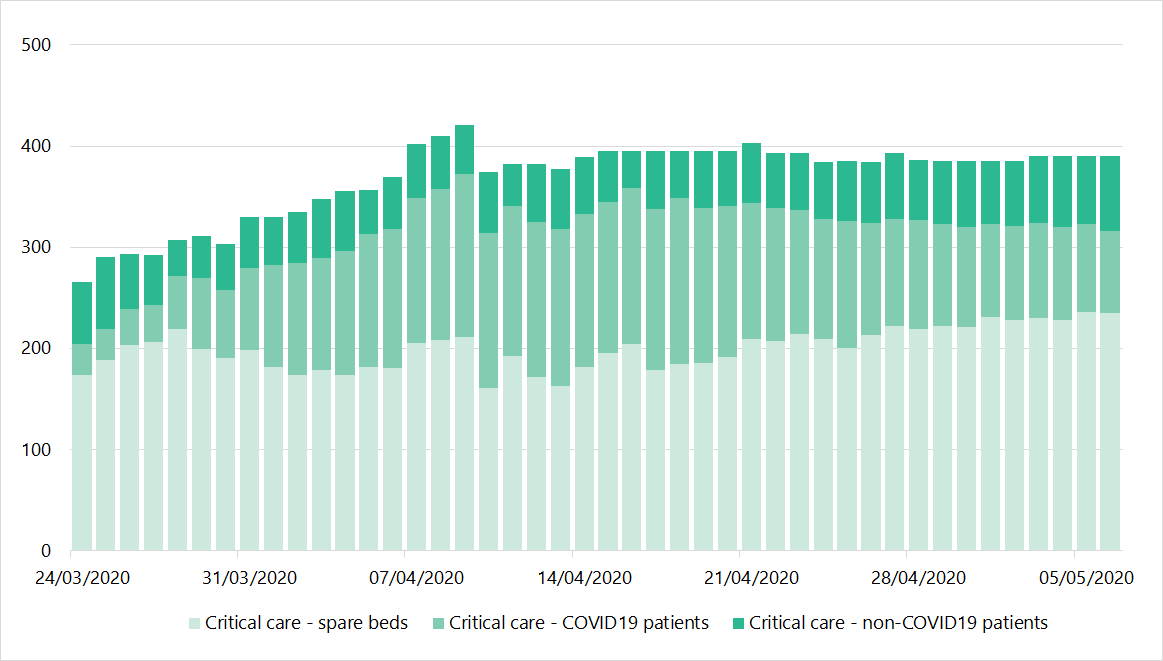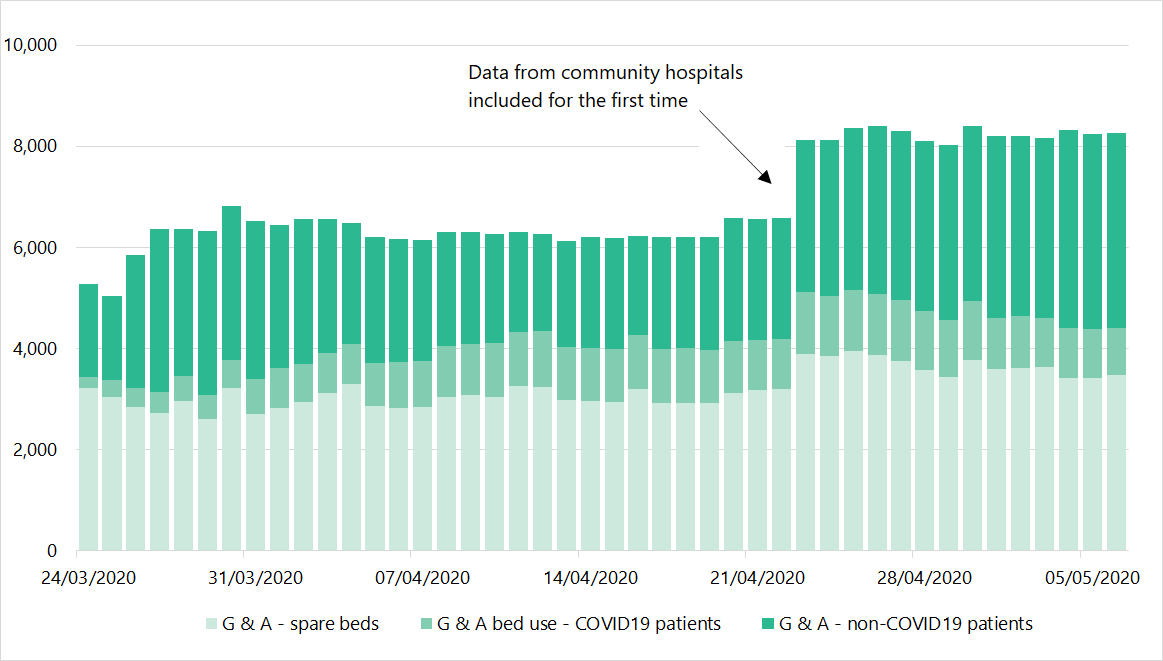Dr Andrew Goodall, NHS Wales’ Chief Executive, has been leading the Thursday press briefings on behalf of the Welsh Government. The NHS boss outlines the latest statistics and how NHS Wales is coping in the fight against coronavirus.
The Welsh Government publish weekly data on cases, deaths, hospitalisations, new admissions to hospital, critical care bed use in Wales, ambulance calls, 111 calls and daily A&E attendances. The next statistical release will be published later today (at 12.30pm).
This article looks at how NHS Wales has responded to the pandemic so far.
NHS activity and capacity
At last week’s press conference, Dr Goodall reported that coronavirus cases in Wales have stabilised; he said the number of people with coronavirus being treated by NHS Wales is falling, and that there are fewer new confirmed cases every day.
On 7 May, Dr Goodall said around 1,020 patients in Welsh hospitals were being treated for coronavirus, or suspected coronavirus – that number changes daily.
According to the latest statistics, around 40 per cent of general and acute hospital beds in NHS Wales (around 3,474) are currently empty, and around 60 per cent of the available critical care beds (around 235) are unoccupied.
Number of critical care beds by use
 Note: Field hospitals included from 21 April 2020 and community hospitals included from 23 April 2020. COVID19 patients include both suspected and confirmed COVID 19 cases.
Note: Field hospitals included from 21 April 2020 and community hospitals included from 23 April 2020. COVID19 patients include both suspected and confirmed COVID 19 cases.Source: NHS Wales Informatics Service (NWIS) Data as at 6 May 2020.
Number of general and acute beds by use
 Note: Field hospitals included from 21 April 2020 and community hospitals included from 23 April 2020. COVID19 patients include both suspected and confirmed COVID 19 cases.
Note: Field hospitals included from 21 April 2020 and community hospitals included from 23 April 2020. COVID19 patients include both suspected and confirmed COVID 19 cases.Source: NHS Wales Informatics Service (NWIS) Data as at 6 May 2020.
Some coronavirus patients’ needs can be met through normal ward care, or with support from critical care staff on an acute ward; other patients may need more specialist support (i.e. critical care in a high dependency unit or intensive care). The NHS has different levels of critical care, based on the clinical needs of patients. The coronavirus pandemic has increased the demand for NHS services, particularly services like critical care, which treat patients with severe acute respiratory disease.
Preparing for the pandemic
It became clear as the coronavirus spread across Europe – from the experience of countries like Italy and Spain, that the virus would place considerable pressure on critical care services.
The First Minister Mark Drakeford warned that NHS Wales could be “overwhelmed” by the virus.
On 11 March, Dr Parry-Jones, an intensive care consultant in Newport and Cardiff raised concerns that Wales was “uniquely at risk” if there was a surge of very sick people with coronavirus because of a lack of intensive care beds here. At the start of the pandemic, Wales had fewer critical care beds than the rest of the UK, and the UK had fewer than many countries in Europe.
Wales’ Health Minister Vaughan Gething confirmed that NHS Wales usually had around 153 critical care beds.
Reducing demand for critical care
Health Boards in Wales are used to dealing with surges of demand, and have plans in place to increase bed capacity in their hospitals – for example, during the winter period. However, it was recognised that there needed to be significant scaling up of critical care capacity to deal with the virus.
The Welsh Government took the decision on 13 March 2020 to free-up critical care capacity and prepare for a large number of hospital patients requiring critical care support by postponing routine surgery (the other UK nations announced similar plans shortly afterwards). NHS hospitals were asked to postpone non-urgent planned operations, reducing the need for critical care support in the period immediately after complex surgery. The move would also increase the number of hospital ward beds that patients with coronavirus could be discharged to. Non-urgent treatment and non-urgent outpatient appointments were put on hold, however the Welsh Government has stressed that access to cancer and other essential treatments such as kidney dialysis should continue.
However, concerns have been raised by clinicians about the “dramatic drop” in people seeking medical help for non-coronavirus related illnesses. A 35 per cent drop in emergency hospital admissions has been reported. On 6 May, NHS Wales and Welsh Government published an NHS Wales COVID-19 operating framework for quarter 1 (2020/21) and issued guidance to ensure the health system delivers essential services.
It is not unusual for individual Health Boards to temporarily cancel planned surgery as a way of easing pressure on NHS services. It was used to relieve demand in the winter period caused by winter pressures a matter of weeks before the coronavirus pandemic was declared. A number of Welsh hospitals were already hitting high escalation levels in December 2019 and postponing planned operations in January 2020. But for this to be directed centrally by NHS Wales is unprecedented.
The Welsh Government’s response has also included several other important areas of action including;
- Increase staffing capacity. Staff have been redeployed and those who had critical care skills such as anaesthetists have been asked to work in critical care units. Nurses with previous intensive care experience have been asked to undertake refresher training, and recently retired doctors and nurses have been brought back to provide additional support.
- Procuring more equipment. Critical care services rely on complex equipment such as oxygen supplies and mechanical ventilators that help patients breathe. The Health Minister Vaughan Gething confirmed that Welsh hospitals had 415 ventilators which could provide invasive ventilation in the early days of the virus, with a further 349 anaesthetic machines with ventilator capacity and 207 non-invasive ventilators (6 April), with an additional 1,035 being procured. Welsh businesses have helped to manufacture ventilators as well as additional coronavirus testing kits for the NHS. Ensuring an adequate stock of Personal Protective Equipment (PPE) has also been a key issue – you can read more about that in our PPE blog post.
- Increase critical care beds. The NHS was asked to plan for a considerable increase in the number of critical care beds to support patients. This has been achieved through existing NHS hospitals expanding their critical care capacity – for example, by adapting operating theatres and recovery areas into temporary intensive care units. Use of critical care facilities and equipment operated by the private sector has also been part of the planning. By 5 April, the number of critical care beds in Welsh hospitals had more than doubled – to around 350.
- Field hospitals. As well as increasing the supply of critical care beds, extra hospital beds have been created by NHS Wales for patients recovering from the virus to be discharged to. In a statement on 5 April, the Health Minister stated that up to 7,000 extra hospital beds were being created. Local authorities in Wales were given emergency powers to support NHS Wales with the new field hospitals. Some of these temporary NHS hospitals include use of the Principality Stadium in Cardiff, Parc y Scarlets in Llanelli, Bluestone in Pembrokeshire and Venue Cymru in Llandudno. Every Health Board has worked to increase hospital, community and care home bed numbers. Details on the capacity and use of the field hospitals was published by Welsh Government on 5 May.
Asking the public to stay-at-home
The central coordination of the message from the four UK nations asking the public to stay-at-home has also been a key area of action to protect the NHS.
While the NHS has been focused on increasing the supply of beds and staffing, ‘lockdown’ measures asking the public to stay-at-home (announced by the UK and Welsh Governments on 23 March), are intended to protect the NHS by reducing the spread of the virus and the peak amount of patients who would require critical care support at any one time.
Despite some policy divergence, the four UK nations have moved together on this. However, while Wales, Scotland and Northern Ireland remain in lockdown (albeit with some minor amendments to the regulations in Wales), the UK Prime Minister announced changes for England on 10 May.
The First Minister of Wales, Mark Drakeford explained why the stay-at-home message in Wales has not changed on 8 May.
At last week’s press conference, Dr Goodall stated “there is going to have to be a careful balancing act in terms of the lockdown being lifted”.
Dr Goodall reported that around 2,800 patients treated in Welsh hospitals for coronavirus have recovered and been discharged. But he also stressed that while Wales seems to have “passed the peak” of cases, new cases continue to be diagnosed in Wales every day.
As of Wednesday 13 May a total of 1,154 people have died after testing positive for coronavirus, according to Public Health Wales figures. Public Health Wales publishes figures on the number of deaths daily, mostly from hospitals, which have all been confirmed by laboratories as involving coronavirus. (The Office for National Statistics publishes weekly figures which include all registered deaths, including those in care homes and at home, where coronavirus is suspected, as well as confirmed cases. According to figures they published on Tuesday 12 May, there have been 1,641 deaths involving coronavirus so far in Wales).
Easing lockdown restrictions in Wales
The Welsh Government has set out its framework for ‘Leading Wales out of the coronavirus pandemic’. It states that NHS Wales has coped well with the pandemic and is continuing to build capacity. It also sets out how it will continue to monitor the reproduction rate of the virus, and its plans to build-up the test, track and trace capability. It states that these actions, taken together, will enable Welsh Government to take incremental steps over the coming weeks and months to “ease restrictions when it is safe to do so”.
Article by Sarah Hatherley, Senedd Research, Welsh Parliament
We’ve published a range of material on the coronavirus pandemic, including a post setting out the help and guidance available for people in Wales and a timeline of Welsh and UK governments’ response.
You can see all our coronavirus-related publications by clicking here. All are updated regularly.






